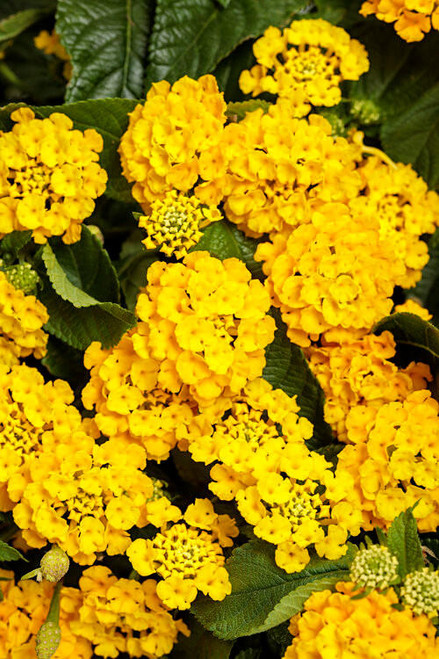Product Description
Lantana 'Luscious Royale Lemon Tart' PPAF (10)ct Quarts
The Luscious of Lantana are colorful, tough, durable plants that will bloom like crazy when the heat does its worst and will tolerate dry conditions.
- Long Blooming
- Heat Tolerant
- Deadheading Not Necessary
- Drought Tolerant
- Attracts: Bees, Butterflies, Hummingbirds
Hardiness Zones: 9, 10, 11
Height: 12 - 26 Inches
Spacing: 12 - 24 Inches
Spread: 12 - 24 Inches
Flower Colors: Yellow
Flower Shade: Yellow
Foliage Colors: Green - Dark Green
Habit: Mounded
Sun
Bloom Time: until Hard Frost
Water: Average
Average Soil
Border Plant, Container, Mass Planting
Lantana 'Luscious Royale Lemon Tart' is a vibrant and cheerful flowering plant that brings a burst of sunshine to gardens and landscapes. This cultivar is part of the Luscious Royale series, known for its compact, mounded habit and prolific blooms.
- Flowers: Bright, lemon-yellow, star-shaped flowers that cluster in abundance, creating a vibrant display.
- Bloom Time: Continuous blooming from spring to fall, providing long-lasting color.
- Foliage: Medium-green foliage with a slightly serrated edge, forming a dense, mounded backdrop for the flowers.
- Growth Habit: Compact and upright, reaching a height of 12-26 inches and a spread of 12-24 inches.
- Hardiness Zones: 9-11 (grown as an annual in colder zones)
- Light: Full sun (at least 6 hours of direct sunlight)
- Soil: Well-drained soil with a pH of 6.0-6.5
- Water: Drought tolerant once established, but benefits from regular watering during hot, dry periods.
Benefits:
- Attracts Pollinators: A favorite of butterflies, bees, and hummingbirds, bringing life and activity to the garden.
- Heat and Drought Tolerant: Thrives in hot, sunny conditions and can withstand periods of dryness.
- Long Blooming Season: Provides continuous color throughout the growing season.
- Low Maintenance: Requires minimal deadheading and pruning.
- Versatile: Suitable for containers, hanging baskets, borders, and mass plantings.
Growing Tips:
- Planting: Space plants 12-24 inches apart to allow for adequate air circulation.
- Watering: Water regularly during the first growing season to establish a strong root system. Once established, it can tolerate drier conditions.
- Fertilizing: Feed with a balanced fertilizer in spring and mid-summer for optimal growth and flowering.
- Pruning: Trim back as needed to maintain shape and encourage bushier growth.
- Overwintering: In colder zones, it can be overwintered indoors as a houseplant or grown as an annual.
If you are looking for a low-maintenance, heat-loving plant that provides a continuous display of cheerful yellow flowers, Lantana 'Luscious Royale Lemon Tart' is an excellent choice. Its compact habit and vibrant blooms make it a versatile addition to any sunny garden or landscape.
Ten (10) plants in quart containers per flat (or tray).
Other Details
The most important part of the plant is its root system. Healthy roots are the foundation of a healthy, vibrant plant. The type of plug container used is based on the specific needs of the plants. Perennials offered as bare root traditionally perform better when planted as bare root.Planted in a specialized mix, potted plants have well established root systems. Top growth stage will vary depending on the current life cycle and time of year when shipped. In Winter and early Spring dormant plants may be shipped. Dormant plants may be planted right away, even before the last frost date.
Most bare root varieties are field grown for at least one season, though Hemerocallis and Hosta are grown for two seasons. The bulk of the soil is removed during the harvesting process and the tops of most varieties are trimmed back to the crown. They are graded, packed in shredded aspen or sphagnum moss and stored in freezers until ready to be shipped.
See our Container Sizes and Bare Root Perennials pages for more information.
Plant information and care is provided in the Overview section, Plant Genus Page and general information is provided in the Planting Care & Guides. Additional questions can be asked on each Plant page.
Plant Spacing: Using the maximum mature spread or width of a plant to guide spacing, ensures space to grow to full size. To fill an area sooner, plant them closer together. Just remember, future thinning or transplanting may be needed.
Water: Keep a close eye on newly planted perennials, especially throughout the first growing year. Most early plant loss is due to too much or too little water!



